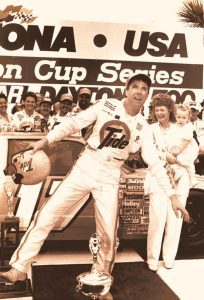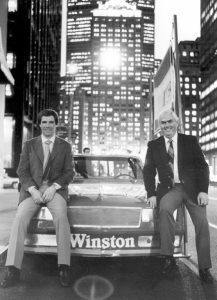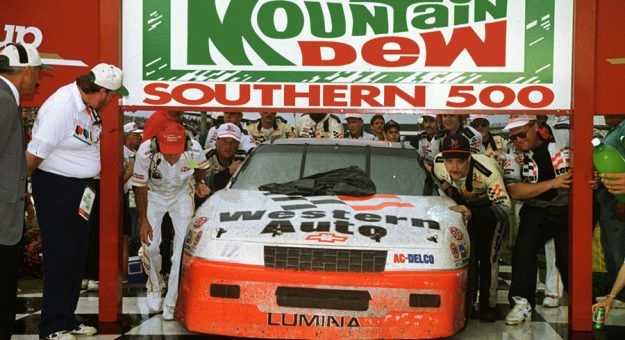Adjectives such as witty, confident, cocky, outspoken and determined only scratch the surface while describing three-time NASCAR Cup Series champion Darrell Waltrip.
Arguably, there isn’t a NASCAR fan on the planet who doesn’t know the larger-than-life figure from Owensboro, Ky. He retired from driving in 2000 with 84 victories and was inducted into the NASCAR Hall of Fame in 2011.
During his formative years in NASCAR from 1972 through 1980, it’s fair to say Waltrip ruffled more than a few feathers while establishing himself as one of NASCAR’s brightest stars.
His entrance into NASCAR’s premier series came at a time when drivers were tough, cars were more difficult to drive and the sport was still finding its footing among stick-and-ball sports.
“I loved the attention I was getting,” Waltrip said about his bold persona in the 1970s. “The other guys were big superstars. I wanted to be a superstar. Whatever it took, I was up for anything.”
Waltrip’s story began on the short tracks where he won multiple championships. He graduated to sportsman and ARCA competition. He made his first superspeedway outings at Texas World Speedway and Talladega (Ala.) Superspeedway, driving the same Holman Moody-built 1967 Ford Fairlane with which Mario Andretti won the 1967 Daytona 500.
The car was changed to a 1971 Ford when Waltrip purchased it for $12,500 in 1972.
After a couple of rather extensive crashes, the car was transformed into a 1972 Mercury Cyclone. That’s when Waltrip made his first Cup Series start.
“My first Cup race was at Talladega that year,” Waltrip said. “James Hylton won that race. I had my old tires that were slicks. Goodyear had new treaded tires but they would run about 10 laps and fly all to pieces. James and I had a battle for the win and I had engine trouble late in the race and he went on to win it. I came close to winning in my first shot at Cup. That really helped my confidence. I had Jake Elder working for me as my crew chief. I had a pretty good car. From there, we just kept building on that little bit of success and ran six races that season.”

In 1973, Waltrip made five Cup Series starts for Bud Moore. As an owner-driver, Waltrip ran 14 races that year, 16 races in ’74 and 17 races in ’75. He scored a Cup Series victory at Nashville Speedway on May 10, 1975. Waltrip also won a Cup Series race at Richmond (Va.) Raceway in October.
“I always heard if you could win at Nashville you could win anywhere,” Waltrip said. “I won 70 races there, so when the Cup Series, or then Grand National Series, came to Nashville, I knew I could win against them anywhere else. I won a Cup race against them in 1975 in my own car. That was the mentality I had.
“When I went into Cup, I knew they were great drivers, but I knew I was as good or maybe better than they were if everything was equal.”
In 1976, Waltrip joined Bill Gardner’s DiGard Racing with Gatorade as the team’s sponsor. Waltrip’s ability behind the wheel, along with strong mechanical talent, brought championship aspirations. Together, they would win 24 races through Sept. 14, 1980.
“I was very confident in my ability,” Waltrip said. “I felt I was as good as anybody but also, I had Jake Elder, (engine builder) Robert Yates, (crew chief) Buddy Parrott, (crewman) David Ifft and (crewman) Gary Nelson. There were a lot of people who were in the same boat I was in. They all knew they were good but needed to be given the opportunity to prove it. We just kind of proved it together. We did that with the Gatorade car.”
Waltrip and Bobby Allison were great friends when Waltrip came into the Cup Series in 1972. Oftentimes they would travel to races together and work on cars together. As they became more competitive, that friendship became more strained.
“Bobby was a great friend of mine,” Waltrip said. “He helped me a lot when I first got started. He taught me about the cars, what it took to make them handle, what it took to make them run well. I just had a lot of good people around me. I soaked the knowledge in like a sponge. I was soaking something in every day. I knew I had the ability. I just needed the opportunity and that eventually came.
“Bobby and Judy and I went to races together. Bobby built cars for me. Bobby really taught me everything I knew about a race car, such as technical things and so many things you need somebody to show you how they work,” Waltrip continued. “We were great friends until all the sudden I started driving the Gatorade car and we got pretty competitive and started winning. Then, when I started driving for Junior Johnson in 1981 and Bobby didn’t have a lot of love for Junior Johnson and we started competing heavily for the championships in 1981, ’82 and ’83, then our friendship went off the rails.”
Allison also feels the competitiveness influenced their friendship.
“He was a pretty good racer and the cars he drove were pretty good, but yes, he made some enemies when he first came into the Cup Series,” Allison recalled. “We did help one another quite a bit. We were good friends early on and his wife, Stevie, and my wife, Judy, hit it off immediately. I built some cars for him in the very beginning. But as time went on, the friendship was not as strong as it once was. When we got into battling so intensely for wins on the track in the late 1970s and then for championships in the early 1980s, we just didn’t move forward on a personal level.”

The rivalry between Waltrip and Cale Yarborough was also intense at times during the 1970s. It came during a time when the movie “Jaws” was at the height of popularity. During the 1977 Southern 500 at Darlington (S.C.) Raceway, a five-car crash took Waltrip and Yarborough out of the race. That’s where Yarborough tagged Waltrip with the nickname, telling fellow driver D.K. Ulrich, “I didn’t touch you. ‘Jaws’ Waltrip hit you and knocked you into the wall. You came off the wall and hit me. That’s what happened. It was totally uncalled for.”
“Cale called me ‘Jaws’ and I called him ‘Short Neck’ because he didn’t have one,” Waltrip said. “If he had a nickname, that’s what most people would have called him back in that era.”
Ever the showman, H.A. “Humpy” Wheeler, longtime president and general manager of Charlotte Motor Speedway, displayed a real chicken and shark on the back of a wrecker and had them driven around the track prior to the 500-mile event there in October 1977.
Wheeler compared Waltrip’s rise to the top to another extremely popular athlete of that era because of his extremely vocal prowess with the media and his fans.
“A lot of what Darrell was saying was exactly what Muhammad Ali did during his boxing career,” Wheeler said. “I have read every book ever written on Muhammad Ali and it’s carbon copy. Darrell just went in there, partially in the worst environment, because he’s telling this to guys that are wanting to run him in the wall. If you look at Thomas Hauser’s biography of Muhammad Ali, you’ll see Darrell Waltrip all through that and how a new guy on the block, whether it be Ali or Waltrip, starts talking to the noted celebrities in the business and letting them know that he’s there to stay and get out of my way.
“You have to give Darrell credit because it took a great deal of gumption to do that in those days with those established drivers,” Wheeler added. “You’re talking about some rough guys with Dale Earnhardt, Buddy Baker, David Pearson and Cale Yarborough.”
Waltrip says the wars of the past are in the past and strong friendships exist today.
“We are better friends today than we were in the 1970, ’80s and ’90s when we raced each other,” Waltrip said. “When you’re not driving anymore and you’re not competing against someone, you’re great friends. You have to remember that when you won a race in those days, you felt like you were taking food off their table and they were taking food off of yours.
“But today, myself, Cale, Bobby, Richard, we look back on some of the things that were said or done and we sit back and laugh about it now. We say, ‘I can’t believe we were that big of jerks about all of that at the time.’ I can’t believe we were going at each other like that at the time. Now we’re all great friends.”
